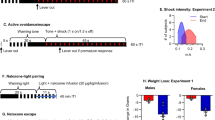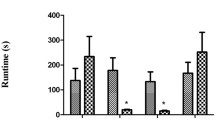Abstract
Rationale
The nature of the relationship between the dose of a drug of abuse and its reinforcing effect has come under close scrutiny. It is currently debated if the steep ascending part of the biphasic dose-response curve typically obtained in multiple-dosing lever-press-based operant conditioning procedures represents a satiety-driven, all-or-none response or if the response is gradual and tightly adjusted to the various doses of the reinforcer.
Objectives
Dose-response relationships of drug reinforcers (remifentanil, alfentanil, morphine, cocaine) as well as a physiological reinforcer, i.e. food (sweetened condensed milk) were investigated in a different operant conditioning paradigm, i.e. a runway procedure.
Methods
Administration of the mu opioid receptor agonists remifentanil (0.0032–0.1 mg/kg IV), alfentanil (0.032 mg/kg IV), morphine (0.032–1 mg/kg IV), the psychostimulant cocaine (0.001–0.1 mg/kg IV) or sweetened condensed milk (diluted 1:100–1:3 in water) was made contingent upon alley running for male Sprague-Dawley rats.
Results
All drug reinforcers dose-dependently decreased runtimes and, more importantly, significantly increased the percentage of runs at a certain speed (≥10 cm/s) from an average 29% to an average 71% (water versus milk, 22% versus 83%).
Conclusion
Both drug- and food reinforcers produced a discontinuous, qualitative change in the rats' operant behavior rather than a simple gradual increase along a continuum, an effect that could be seen clearly only after a histogram analysis of runtime distribution.





Similar content being viewed by others
References
Bardo MT, Rowlett JK, Harris MJ (1995) Conditioned place preference using opiate and stimulant drugs: a meta-analysis. Neurosci Biobehav Rev 19:39–51
Bozarth MA (1987) Methods of assessing the reinforcing properties of abused drugs. Springer, New York
Briscoe RJ, Winger G, Lewis JW, Woods JH (2000) Methoclocinnamox: time course of changes in alfentanil-reinforced responding in rhesus monkeys. Psychopharmacology 148:393–399
Collins RJ, Weeks JR, Cooper MM, Good PI, Russell RR (1984) Prediction of abuse liability of drugs using IV self-administration by rats. Psychopharmacology 82:6–13
Corrigall WA, Linseman MA, D'Onofrio RM, Lei H (1986) An analysis of the paradoxical effect of morphine on runway speed and food consumption. Psychopharmacology 89:327–333
Ettenberg A, Geist TD (1991) Animal model for investigating the anxiogenic effects of self- administered cocaine. Psychopharmacology 103:455–461
Ettenberg A, Geist TD (1993) Qualitative and quantitative differences in the operant runway behavior of rats working for cocaine and heroin reinforcement. Pharmacol Biochem Behav 44:191–198
Ettenberg A, MacConell LA, Geist TD (1996) Effects of haloperidol in a response-reinstatement model of heroin relapse. Psychopharmacology 124:205–210
Ettenberg A, Raven MA, Danluck DA, Necessary BD (1999) Evidence for opponent-process actions of intravenous cocaine. Pharmacol Biochem Behav 64:507–512
Flory GS, Woods JH (2003) The ascending limb of the cocaine dose-response curve for reinforcing effect in rhesus monkey. Psychopharmacology 166:91–94
Geist TD, Ettenberg A (1990) A simple method for studying intravenous drug reinforcement in a runway. Pharmacol Biochem Behav 36:703–706
Geist TD, Ettenberg A (1997) Concurrent positive and negative goalbox events produce runway behaviors comparable to those of cocaine-reinforced rats. Pharmacol Biochem Behav 57:145–150
Gesztesi Z, Rego MM, White PF (2000) The comparative effectiveness of fentanyl and its newer analogs during extracorporeal shock wave lithotripsy under monitored anesthesia care. Anesth Analg 90:567–570
Grimes JA, Shull RL (2001) Response-independent milk delivery enhances persistence of pellet-reinforced lever pressing by rats. J Exp Anal Behav 76:179–194
Haidar SH, Moreton JE, Liang Z, Hoke JF, Muir KT, Eddington ND (1997) Evaluating a possible pharmacokinetic interaction between remifentanil and esmolol in the rat. J Pharm Sci 86:1278–1282
Lopez HH, Ettenberg A (2001) Dopamine antagonism attenuates the unconditioned incentive value of estrous female cues. Pharmacol Biochem Behav 68:411–416
McFarland K, Ettenberg A (1997) Reinstatement of drug-seeking behavior produced by heroin-predictive environmental stimuli. Psychopharmacology 131:86–92
McFarland K, Ettenberg A (1999) Haloperidol does not attenuate conditioned place preferences or locomotor activation produced by food- or heroin-predictive discriminative cues. Pharmacol Biochem Behav 62:631–641
Meisch RA, Lemaire GA (1993) Drug self-administration. In: vanHaaren F, Huston JP (eds) Techniques in the behavioral and neuronal sciences. Elsevier, Amsterdam, pp 257–300
Mello NK, Negus SS (1996) Preclinical evaluation of pharmacotherapies for treatment of cocaine and opioid abuse using drug self-administration procedures. Neuropsychopharmacology 14:375–424
Panlilio LV, Schindler CW (2000) Self-administration of remifentanil, an ultra-short acting opioid, under continuous and progressive-ratio schedules of reinforcement in rats. Psychopharmacology 150:61–66
Raven MA, Necessary BD, Danluck DA, Ettenberg A (2000) Comparison of the reinforcing and anxiogenic effects of intravenous cocaine and cocaethylene. Exp Clin Psychopharmacol 8:117–124
Rosow CE (1999) An overview of remifentanil. Anesth Analg 89:S1–S3
Scholz J, Steinfath M, Schulz M (1996) Clinical pharmacokinetics of alfentanil, fentanyl and sufentanil. An update. Clin Pharmacokinet 31:275–292
Schuster CR, Johanson CE (1981) An analysis of drug-seeking behavior in animals. Neurosci Biobehav Rev 5:315–323
Sizemore GM, Martin TJ (2000) Toward a mathematical description of dose-effect functions for self-administered drugs in laboratory animal models. Psychopharmacology 153:57–66
Stolerman I (1992) Drugs of abuse: behavioural principles, methods and terms. Trends Pharmacol Sci 13:170–176
Tsibulsky VL, Norman AB (1999) Satiety threshold: a quantitative model of maintained cocaine self-administration. Brain Res 839:85–93
Weeks JR, Collins RJ (1979) Dose and physical dependence as factors in the self-administration of morphine by rats. Psychopharmacology 65:171–177
White N, Sklar L, Amit Z (1977) The reinforcing action of morphine and its paradoxical side effect. Psychopharmacology 52:63–66
Winger GD, Palmer RK, Woods JH (1989) Drug-reinforced responding: rapid determination of dose-response functions. Drug Alcohol Depend 24:135–142
Young AM, Herling S (1986) Drugs as reinforcers: studies in laboratory animals. Academic Press, Orlando
Zernig G, Lewis JW, Woods JH (1997) Clocinnamox inhibits the intravenous self-administration of opioid agonists in rhesus monkeys: comparison with effects on opioid agonist-mediated antinociception. Psychopharmacology 129:233–242
Zernig G, Harbig P, Weiskirchner I, Auffinger M, Wakonigg G, Saria A (2002) Reinforcing effect of subcutaneous morphine in a modified Ettenberg runway. J Mol Neurosci 18:135–142
Acknowledgements
This study was supported by the Austrian Federal Ministry of Science (research contract GZ 70.071/2-Pr/4/2000) and the Austrian Science Fund (SFB 00206). We gratefully thank Georg Kemmler for his advice in regard to the statistical evaluation of the data.
Author information
Authors and Affiliations
Corresponding author
Rights and permissions
About this article
Cite this article
Wakonigg, G., Sturm, K., Saria, A. et al. Opioids, cocaine, and food change runtime distribution in a rat runway procedure. Psychopharmacology 169, 52–59 (2003). https://doi.org/10.1007/s00213-003-1488-9
Received:
Accepted:
Published:
Issue Date:
DOI: https://doi.org/10.1007/s00213-003-1488-9




